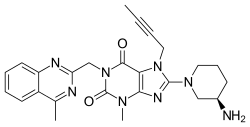Linagliptin
Linagliptin, sold under the brand name Tradjenta among others, is a medication used to treat diabetes mellitus type 2.[2] It is generally less preferred than metformin and sulfonylureas as an initial treatment.[2][3] It is used together with exercise and diet.[2] It is not recommended in type 1 diabetes.[2] It is taken by mouth.[2]
 | |
| Clinical data | |
|---|---|
| Pronunciation | /ˌlɪnəˈɡlɪptɪn/ LIN-ə-GLIP-tin |
| Trade names | Tradjenta, Trajenta, others |
| Other names | BI-1356 |
| AHFS/Drugs.com | Monograph |
| MedlinePlus | a611036 |
| License data |
|
| Pregnancy category |
|
| Routes of administration | By mouth (tablets) |
| ATC code | |
| Legal status | |
| Legal status | |
| Pharmacokinetic data | |
| Bioavailability | ~30% (Tmax = 1.5 hours) |
| Protein binding | 75–99% (concentration-dependent) |
| Metabolism | Minimal (~10% metabolized) |
| Metabolites | Pharmacologically inactive |
| Elimination half-life | ~24 hours |
| Excretion | Feces (80%), urine (5%)[1] |
| Identifiers | |
| |
| CAS Number | |
| PubChem CID | |
| IUPHAR/BPS | |
| ChemSpider | |
| UNII | |
| KEGG | |
| ChEBI | |
| ChEMBL | |
| Chemical and physical data | |
| Formula | C25H28N8O2 |
| Molar mass | 472.553 g·mol−1 |
| 3D model (JSmol) | |
| |
| |
| | |
Common side effects include inflammation of the nose and throat.[2] Serious side effects may include angioedema, pancreatitis, joint pain.[3][2] Use in pregnancy and breastfeeding is not recommended.[3] Linagliptin is a dipeptidyl peptidase-4 inhibitor.[2] It works by increasing the production of insulin and decreasing the production of glucagon by the pancreas.[2]
Linagliptin was approved for medical use in the United States in 2011.[2] In 2017, it was the 200th most commonly prescribed medication in the United States, with more than two million prescriptions.[4][5]
Medical uses
Results in 2010 from a Phase III clinical trial of linagliptin showed that the drug can effectively reduce blood sugar.[6]
Side effects
Linagliptin may cause severe joint pain.[1][7]
The U.S. Food and Drug Administration (FDA) is warning that the type 2 diabetes medicines like sitagliptin, saxagliptin, linagliptin, and alogliptin may cause joint pain that can be severe and disabling. FDA has added a new Warning and Precaution about this risk to the labels of all medicines in this drug class, called dipeptidyl peptidase-4 (DPP-4) inhibitors.
Trajenta's Prescribing Information[8] states the drug is contraindicated for people with bronchial hyperreactivity. Asthma is a form of bronchial hyperreactivity[9].
Mechanism of action
Linagliptin belongs to a class of drugs called DPP-4 inhibitors.
Terminology
See also
References
- "Tradjenta (linagliptin) Tablets. Full Prescribing Information" (PDF). Boehringer Ingelheim Pharmaceuticals, Inc. Ridgefield, CT 06877 USA. Retrieved 10 November 2016.
- "Linagliptin Monograph for Professionals". Drugs.com. American Society of Health-System Pharmacists. Retrieved 6 April 2019.
- British national formulary : BNF 76 (76 ed.). Pharmaceutical Press. 2018. p. 680. ISBN 9780857113382.
- "The Top 300 of 2020". ClinCalc. Retrieved 11 April 2020.
- "Linagliptin - Drug Usage Statistics". ClinCalc. Retrieved 11 April 2020.
- "Four Phase III Trials Confirm Benefits of BI's Oral, Once-Daily Type 2 Diabetes Therapy". Genetic Engineering & Biotechnology News. 28 June 2010.
- "DPP-4 Inhibitors for Type 2 Diabetes: Drug Safety Communication - May Cause Severe Joint Pain". U.S. Food and Drug Administration (FDA). 2015-08-28. Retrieved 1 September 2015.
- https://docs.boehringer-ingelheim.com/Prescribing%20Information/PIs/Tradjenta/Tradjenta.pdf?DMW_FORMAT=pdf)
- Bronchial hyperresponsiveness
- "International Nonproprietary Names for Pharmaceutical Substances (INN). Recommended International Nonproprietary names: List 61" (PDF). World Health Organization. p. 66. Retrieved 10 November 2016.
External links
| Wikimedia Commons has media related to Linagliptin. |
- "Linagliptin". Drug Information Portal. U.S. National Library of Medicine.
- Trajenta (Australia)
- "Trajenta EPAR". European Medicines Agency (EMA).